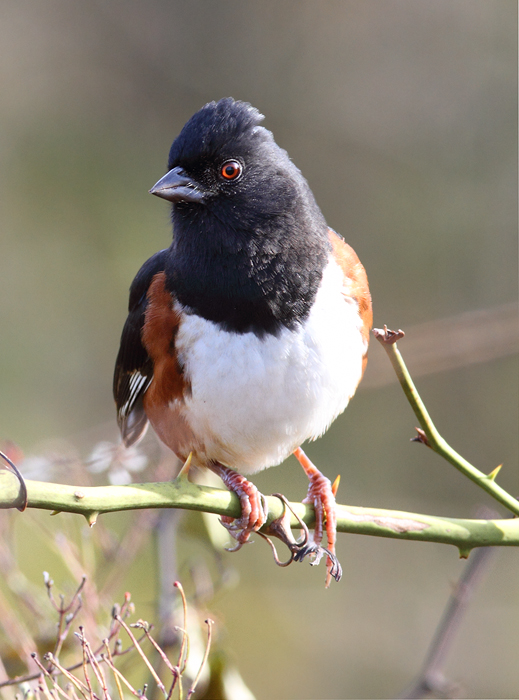
Pipilo erythrophthalmus
TAXONOMY
Fringilla erythrophthalma Linnaeus, 1758, South Carolina. Four
subspecies.
OTHER COMMON NAMES
English: Red-eyed towhee, rufous-sided towhee; French: Tohiа
flancs roux; German: Rцtelgrundammer; Spanish: Rascador
Ojirrojo.
PHYSICAL CHARACTERISTICS
7–8 in (17–20.5 cm); 1.2–1.8 oz (35–50 g). Sexually dimorphic,
large, long-tailed sparrows. Males have a black head, throat
back, and tail, white at the base of the primary wing feathers,
rusty flanks, and a white belly. Females are patterned as males
but are a warm brown where the males are black. Eye color
varies from bright red in the north to yellowish or whitish in
the southeast United States. Juveniles are brownish and are
streaked below.
DISTRIBUTION
Breed from southern Manitoba, east across southern Canada,
and south to Florida and the Gulf Coast (west to Texas). In
winter, they migrate from the northern part of the breeding
range southward and to eastern Texas and central Oklahoma.
The four subspecies differ slightly in size and in eye color.
HABITAT
Inhabit dense deciduous thickets or edges of woodlands. In the
South they may be found in scrub palmetto.
BEHAVIOR
Solitary or occur in pairs or family groups. Males often sing
from a conspicuous perch in the top of a tall bush or from a
tree. When not singing they can be difficult to see.
FEEDING ECOLOGY AND DIET
Forage on the ground by scratching in leaf litter for insects or
seeds.
REPRODUCTIVE BIOLOGY
Monogamous. The nest is placed in a depression in the ground
under a bush or occasionally low in a bush or vine. Nesting occurs
between April and mid-August. Clutch size is two to six
(usually three to four) eggs. Incubation takes 10–12 days and
young leave the nest after 8–10 days. Both parents feed the
young.
CONSERVATION STATUS
Not threatened.
SIGNIFICANCE TO HUMANS
None known.
Photo Gallery of - Eastern towhee




 Animalia Life
Animalia Life